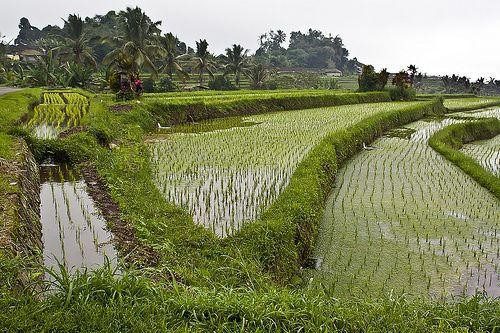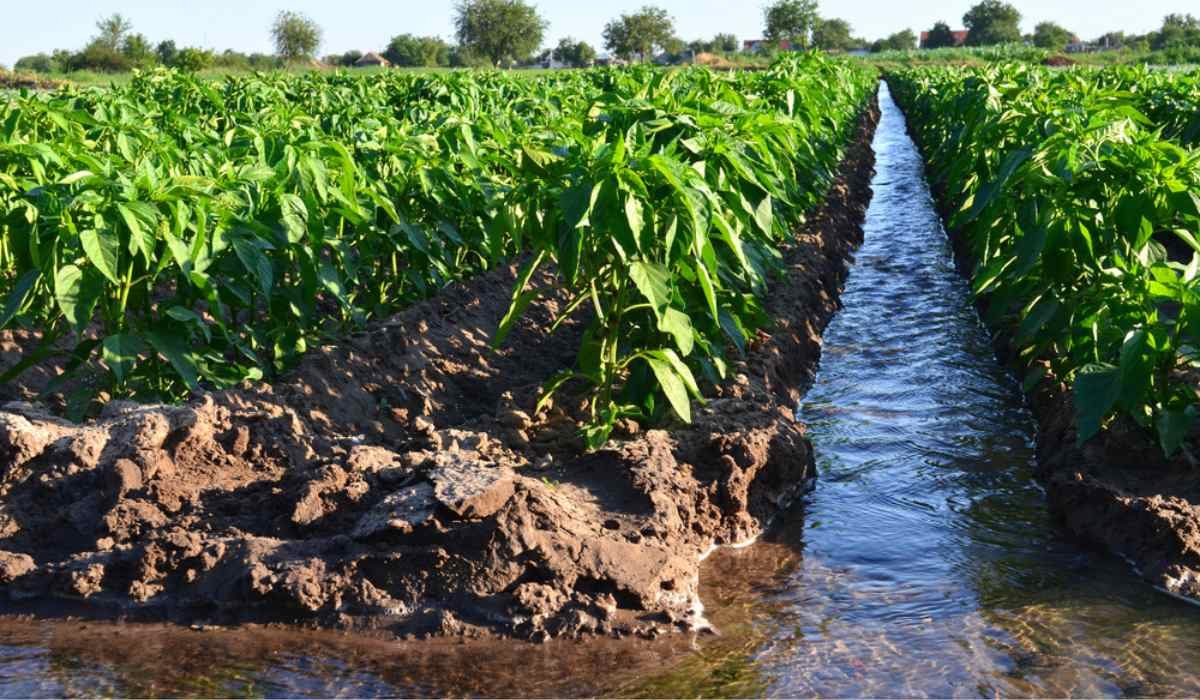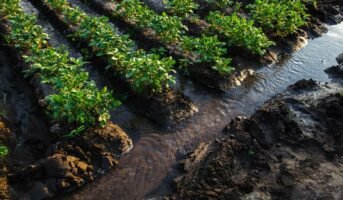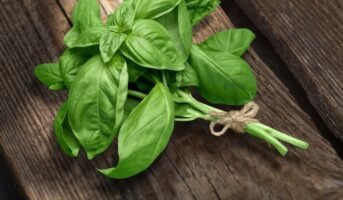In the simplest terms, a small field, level in every direction with little chance of runoffs, is referred to as a basin. It supports a unidirectional flow of water, which helps to create a pond-like system where the roots of the crops are submerged. Now, not all crops are amenable to basin irrigation.
What is basin irrigation?
It is the most common form of surface irrigation suitable for deep-rooted crops spaced closely. You may also say that it is a type of flood irrigation, similar to border irrigation, where the water flows through a system of dykes installed in the field into a drainage system located at the end of it.
But in basin irrigation, these dykes keep the water ponded in the field for some time. An artificial, levelled basin is created by flattening the land and surrounding it with raised banks or levees to contain the water.
see also: all about surface irrigation
Basin irrigation: Simple and effective method
Basin irrigation is one of the surface irrigation methods that can be automated with simple and affordable flow controls at the basin inlet. Further, the irrigation method is effective for moderate to slow intake soils and deep-rooted, closely spaced crops. It is considered an effective method of leaching salts from soil profile into deeper groundwater.
Basics of basin irrigation
Basin irrigation is a type of surface irrigation method in which the field is divided into a number of checks or basins through construction of bunds surrounding the flat areas. The process involves a uniform layer of water flowing over the soil. It is widely used for crops that require sufficient moisture with adequate drainage.
What crops require basin irrigation?
Not all crops can benefit from basin irrigation or flooding, as the roots may rot in long-standing water. If a plant cannot tolerate standing in water for more than 24 hours, you should not put it in a basin. For example, all the root crops, like potatoes, carrots, beets, parsnips, cassava, etc., will not be suitable for this kind of flood irrigation. Rice or paddy is a crop that flourishes in this type of irrigation system. Other crops, like clover, alfalfa, row crops such as tobacco, some cereals, and trees like citrus fruit trees and bananas, also do well in this system.

Source: Pinterest
Construction of the basin: Size and other requirements
If the land is not naturally-levelled, it should be flattened before you start farming. Whether you need a large basin or a small one suitable for, say, one tree depends on three key factors:
- Infiltration rate of the soil
- The gradient of the slope
- The amount of water supply
In situations where you have levelled land with uniform soil texture and a never-ending (metaphorically) supply of water, basin irrigation will be most beneficial for your crops. Coming to the depth of the basin, it can range from 5 cm to 20 cm, but the bays should be level; otherwise, the higher ones will suffer from a lack of water, which will flow down to the lower ones (of course).
Now, if there is not enough water or the inflow rate fluctuates, different infiltration times will pose another hazard to the crops. Some will mature faster, while others will suffer from stunted growth issues.
However, there are ways to keep these potential hassles in basin irrigation at bay.
Types of basin irrigation systems
Drain back level irrigation
A shallow ditch (width 5-10 cm) is constructed and fed with water, which is made to run into several parallel basins, one by one. For example, when the water is fed into one basin, where it reaches the same level as the input ditch, all the excess water runs back into the trench and onto the next basin. And this continues till all the basins are full of water. This method improves the basin irrigation system by eliminating any chances of scarcity. Every basin is fed equally with water so that the crops can mature at the same time.
The cascade method

Source: Pinterest
This variant of the basin irrigation system is meant for sloping lands and for crops that require loamy or sandy soils. If these are irrigated using the conventional (direct) method, the percolation losses may surge. Hence, in the cascade system, borrow-furrows are created to channelise the water to the lowest basin first. On filling it, the bund is closed so that the water gets diverted to the next basin automatically. In this way, the terrace nearest to the supply will get irrigated in the end.
Rice grown on slopes of hills is generally irrigated using the cascade method of basin irrigation. The water is allowed to enter the terraces at a low discharge rate, which makes it easy to monitor the drainage flow. No drainage indicates that more water may be required at the cascade, while if there are signs of drainage, the inflow can be reduced to save water.
Basin irrigation system: Benefits
- Time effective – One of the biggest benefits that basin irrigation provides is time efficiency. You do not need to feed the entire field with water. Just open the water channel, and everything will take place automatically, following the science of water flow.
- Less investment – The only investment hear is the labour required to create that ditch, and the cost of water, of course. No wonder paddy farmers opt for this cost-effective method to grow a huge amount of crops every year.
- More trees – You can water multiple trees using this method without spending a fortune. Even in a large field with several basins, this kind of irrigation method can save a lot of time, energy and resources.
Basin irrigation system: Disadvantages
Nothing comes short of cons, and neither is the basin irrigation system completely devoid of drawbacks. The biggest one is it is not suitable for any kind of root crop, as well as some other crops that do not do well in a flooded field. Also, the amount of water wasted in this kind of flood irrigation system is truly a big burden on mother nature. Further, due to the long-standing water, the chances of insect infestations and diseases increase. It may also create health issues for people living near the field area.
FAQs
How to prevent crop drowning in excess water?
Make sure that the basin surface is uniform, and apply the water quickly. Different kinds of soil in one basin may lead to such issues, so check that beforehand. Also, use the right stream size for each basin.
What is a compacted subsoil layer, and how can it affect irrigation?
It is a natural issue where the compact subsoil is created some 30-50 cm below the basin soil surface. This layer is generally less impermeable, leading to water logging in the upper layers. Check for such mishaps and break the subsoil with a plough or ripper before farming.
How can I take care of the basins?
The bunds may get eroded; rodents may dig holes at the sides, and many such issues may occur. You should check the bunds regularly for any such signs and fix them. Also, the level of the basins should be checked from time to time, especially before planting a crop.
Housing News Desk is the news desk of leading online real estate portal, Housing.com. Housing News Desk focuses on a variety of topics such as real estate laws, taxes, current news, property trends, home loans, rentals, décor, green homes, home improvement, etc. The main objective of the news desk, is to cover the real estate sector from the perspective of providing information that is useful to the end-user.
Facebook: https://www.facebook.com/housing.com/
Twitter: https://twitter.com/Housing
Email: [email protected]











